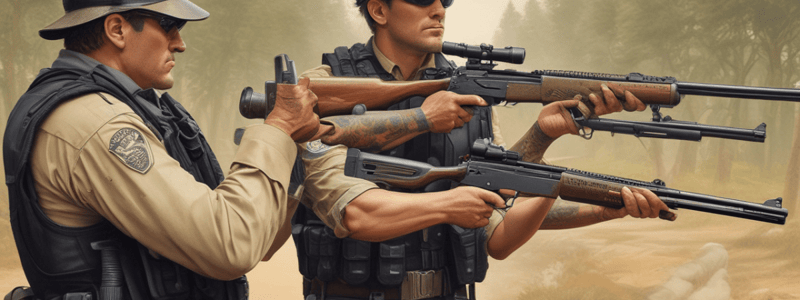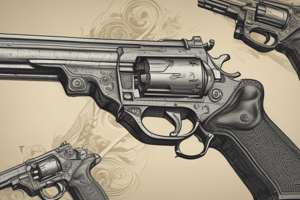Podcast
Questions and Answers
What is the primary objective of the shotgun introduction lesson plan?
What is the primary objective of the shotgun introduction lesson plan?
- To identify the safety principles of the shotgun (correct)
- To identify the five fundamentals of marksmanship
- To identify the nomenclature and operational characteristics of the shotgun
- To demonstrate the proper function testing procedure after re-assembly
Which of the following is NOT a safety principle concerning the handling of the standard police shotgun?
Which of the following is NOT a safety principle concerning the handling of the standard police shotgun?
- Always use a shotgun with a safety mechanism (correct)
- Always treat the weapon as if it is loaded until you have verified that it is safe
- Apply the safety when preparing to inspect, handle, or disassemble the shotgun
- Keep the muzzle pointed in a safe direction
What is the focus of objectives 3-6 in the shotgun introduction lesson plan?
What is the focus of objectives 3-6 in the shotgun introduction lesson plan?
- Shotgun disassembly, inspection, cleaning, and re-assembly (correct)
- Shotgun ammunition and ballistic characteristics
- Shotgun nomenclature and operational characteristics
- Shotgun safety principles
Which of the following is a topic covered in the shotgun introduction lesson plan?
Which of the following is a topic covered in the shotgun introduction lesson plan?
What is the purpose of objective 8 in the shotgun introduction lesson plan?
What is the purpose of objective 8 in the shotgun introduction lesson plan?
What is a key aspect of the shotgun introduction lesson plan?
What is a key aspect of the shotgun introduction lesson plan?
Which of the following is a topic NOT covered in the shotgun introduction lesson plan?
Which of the following is a topic NOT covered in the shotgun introduction lesson plan?
What is the basis for objectives 3-6 in the shotgun introduction lesson plan?
What is the basis for objectives 3-6 in the shotgun introduction lesson plan?
What is the correct way to hold the shotshell when loading it into the ejection port?
What is the correct way to hold the shotshell when loading it into the ejection port?
In what direction should the muzzle be pointed during unloading in the combat load position?
In what direction should the muzzle be pointed during unloading in the combat load position?
What is the correct procedure to remove the remaining shells in the magazine tube during unloading?
What is the correct procedure to remove the remaining shells in the magazine tube during unloading?
What is the fifth fundamental in shooting?
What is the fifth fundamental in shooting?
What is the common malfunction caused by powder residue, rust, or dirt in the chamber?
What is the common malfunction caused by powder residue, rust, or dirt in the chamber?
What is the corrective action for a failure to unlock the action?
What is the corrective action for a failure to unlock the action?
What is the correct procedure to load the first round into the ejection port?
What is the correct procedure to load the first round into the ejection port?
What is the common malfunction caused by a dirty magazine tube or weak magazine spring?
What is the common malfunction caused by a dirty magazine tube or weak magazine spring?
What is the corrective action for a double feed onto the shell carrier?
What is the corrective action for a double feed onto the shell carrier?
What is the primary consideration when loading a shotgun in an assembly area?
What is the primary consideration when loading a shotgun in an assembly area?
What is the emergency combat procedure to correct a failure to fully close the action?
What is the emergency combat procedure to correct a failure to fully close the action?
In which hand should a right-handed shooter carry their ammunition during combat loading?
In which hand should a right-handed shooter carry their ammunition during combat loading?
What is the first step in the assembly area loading procedure?
What is the first step in the assembly area loading procedure?
How should the action be closed after loading the first round in the combat loading procedure?
How should the action be closed after loading the first round in the combat loading procedure?
What is the purpose of the combat loading procedure?
What is the purpose of the combat loading procedure?
How should the shooter's attention be focused during combat loading?
How should the shooter's attention be focused during combat loading?
What is the correct position of the barrel during combat loading?
What is the correct position of the barrel during combat loading?
How should the fingers be positioned to load the first round in the combat loading procedure Option #1?
How should the fingers be positioned to load the first round in the combat loading procedure Option #1?
What is the exception to the combat loading procedure for right-handed loading of semiautomatic shotguns?
What is the exception to the combat loading procedure for right-handed loading of semiautomatic shotguns?
What should be done after verifying the weapon is clear during the assembly area loading procedure?
What should be done after verifying the weapon is clear during the assembly area loading procedure?
What is the primary purpose of checking the chamber, shell carrier/elevator, and magazine tube?
What is the primary purpose of checking the chamber, shell carrier/elevator, and magazine tube?
What type of shotguns operate by a working slide which extracts and ejects a fired shell and cocks the hammer?
What type of shotguns operate by a working slide which extracts and ejects a fired shell and cocks the hammer?
What is the primary difference between delayed blowback and recoil operational types of semi-automatic shotguns?
What is the primary difference between delayed blowback and recoil operational types of semi-automatic shotguns?
What should be checked during the inspection process of the shotgun's firing pin/bolt assembly?
What should be checked during the inspection process of the shotgun's firing pin/bolt assembly?
What is the purpose of using dummy rounds during inspection and function testing?
What is the purpose of using dummy rounds during inspection and function testing?
What should be done if a part or item appears to be damaged or extremely worn during inspection?
What should be done if a part or item appears to be damaged or extremely worn during inspection?
What is the effective range of a rifled slug, 1 ounce of lead, .72 caliber?
What is the effective range of a rifled slug, 1 ounce of lead, .72 caliber?
What is the primary purpose of the cartridge interrupter/cartridge stop assembly?
What is the primary purpose of the cartridge interrupter/cartridge stop assembly?
During the function test, what should happen when the safety is placed in the off position and the trigger is pulled?
During the function test, what should happen when the safety is placed in the off position and the trigger is pulled?
Flashcards are hidden until you start studying
Study Notes
Shotgun Introduction
- The two most commonly used shotguns by law enforcement agencies are the Remington 870 and Mossberg shotguns.
Safety Principles
- Always handle the shotgun with the muzzle pointed in a safe direction.
- Treat the weapon as if it is loaded until you have verified that it is safe.
- Areas that must be checked to verify that the weapon is unloaded and safe include:
- Chamber (Action open)
- Shell carrier/elevator
- Magazine tube
- Use dummy rounds when performing any inspection or function test.
Nomenclature and Operational Characteristics
- Pump Action Shotguns:
- Operate by a working slide that opens the action, extracts and ejects a fired shell, and cocks the hammer.
- Pushing the slide forward chambers a loaded shell from the magazine tube by way of a carrier or elevator.
- Have an ejection port on the right side and a cross-bolt safety in the trigger guard.
- Semi-Automatic Shotguns:
- Do not require any "pumping" action to fire, extract, and feed rounds.
- Each time the trigger is pressed, the semi-automatic shotgun will fire, extract the fired shotshell, and feed a fresh shotshell into the chamber.
- Delayed blowback and recoil are the two most common operational types of semi-automatic shotguns.
Disassembly, Inspection, and Cleaning Procedure
- Manufacturer recommendations will be followed for the particular make and model of shotgun used.
- Specific items to check during the inspection process:
- Cartridge interrupter/cartridge stop assembly arms
- Firing pin/bolt assembly (extractor)
- Ejector mechanism
- Action arm/forearm assembly
- Trigger assembly (elevator — carrier assembly)
- Barrel assembly (to include front sight)
- Magazine tube follower/spring assembly
- Magazine tube (damage and tightness)
Re-assembly and Function Testing
- Manufacturer recommendations will be followed for the particular make and model of shotgun used.
- Function testing includes:
- Operation of Safety
- Loading and unloading procedures
- Chambering and extracting dummy shells
Shotgun Ammunition
- Common shotgun ammunition includes:
- "00" Buck: .33 caliber, penetration at 25 feet, effective range of approximately 15-18 yards
- Rifled Slug: 1 ounce of lead, .72 caliber, penetration at 100 feet, effective range of approximately 75 yards
Inspection and Loading Procedure
- "Assembly Area" loading is defined as loading the shotgun in areas where citizens and/or officers are congregated and the only safe place to point the muzzle is in a safe direction.
- Procedure:
- Grasp shotgun with dominant hand on the pistol grip area
- Point muzzle in a safe direction
- Open slide, inspect chamber, carrier/elevator, and magazine tube for any live ammunition
- Load to maximum capacity into magazine tube by depressing shell carrier with nose of shell and pushing shell into magazine tube past the cartridge stop with the thumb
- In this loading procedure, the chamber of the weapon remains empty and the weapon is de-cocked
Combat Loading Procedure
- Right-Handed Loading Procedure:
- Shotgun is held in the shoulder-fired position with the strong hand
- Muzzle is pointed in the direction of the problem with the barrel parallel to the ground
- Ammunition should be carried on the left side of a right-handed shooter
- First shell to be loaded will be grasped in the left hand at the base of the fingers with the brass portion of the shell resting against the inside of the little finger
- To load the first round, the left hand will pass under the action of the weapon and the fingers will raise the shell along the side of the receiver until the shell drops into the ejection port
- Remaining rounds will be loaded into the loading port, using the left hand to guide the shells into the magazine tube by depressing the carrier/elevator and pushing the round forward with the thumb past the cartridge stop
Unloading the Shotgun
- Unload according to manufacturer recommendation and training center policies
- Assembly Area Unloading:
- Grasp fore-end with support hand
- Strong hand grasps receiver over trigger guard with index finger depressing action release
- Fore-end is slowly moved rearward to open action
- Shell carrier is then pushed upward into receiver, exposing base of the shell in the magazine tube
- The strong hand index finger is placed against the base of the shell and the fore-end is now pulled rearward to release the shell against the index finger
- The remaining shells in the magazine tube are removed by depressing the cartridge stop on the right side of the receiver, allowing the shells to be released one at a time
Fundamentals of Marksmanship
- The five fundamentals of marksmanship:
- Stance
- Grip
- Sighting
- Trigger Action
- Breathing
- The application of the fundamentals: Identify most common malfunctions and clearance with a shotgun, sidearm is always an accepted and tactical response drill.
Malfunction Clearance
-
Failure to Fire: Safety in "on" position
-
Failure to Unlock Action: lock lever not depressed
-
Failure to Extract: Powder residue, rust or dirt in chamber
-
Failure to Eject: Action not opened forcefully
-
Failure to Feed: Dirty magazine tube/weak spring
-
Double Feed: Shell not pushed past cartridge stop
-
Failure to Fully Close: Damaged ammunition, debris/corrosion on bolt
-
Corrective Action:
- Disengage safety
- Depress action lock lever
- Clean chamber
- Clean bolt & extractors
- Use vigorous opening motion
- Clean tube
- Fully push shell into magazine tube
- Replace spring
- Disassemble weapon & correct
- Force open action by striking butt on ground (emergency combat only)
- Replace ammunition
- Clean
Studying That Suits You
Use AI to generate personalized quizzes and flashcards to suit your learning preferences.




